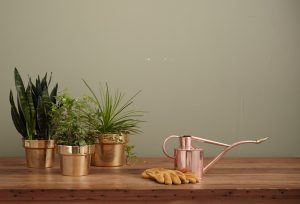By Krista Harper

Poor air quality in your home can have a huge impact on your physical and mental health. Poor air quality can be linked to allergies, asthma, fatigue, and even lung disease. And what most people don’t realize is that the air quality in your home can be up to five times worse than outdoors.
One of the best ways to counter poor air quality is by growing indoor plants throughout your home. Here are five indoor plants that do a great job of improving your home’s air quality.
Peace Lily
According to NASA, the Peace Lily is the most efficient plant to remove volatile organic compounds. It is also relatively easy to grow anywhere in the home with limited sunlight and weekly watering. Keep in mind that the Peace Lily can also be toxic to humans if ingested, and especially toxic to pets if eaten.
Devil’s Ivy
Devil’s Ivy is native to the Solomon Islands, though due to its attractive green and white marble heart-shaped leaves and easy growth it has become a popular home plant throughout the world. Devil’s Ivy is popularly sold in hanging baskets and should be placed near a window, though away from direct sunlight. The soil should be peaty and frequently watered to remain moist.
This plant does a great job cleansing airborne pollutants such as benzene, trichloroethylene, and formaldehyde. Though, it is toxic when ingested.
Red-Edged Dracaena
Wildly popular in the United States due to its uniquely attractive upright evergreen leaves and flowering blooms, this is an incredibly easy plant to grow. The Red-Edged Dracaena grows in an area with indirect sunlight with slightly moist soil. That means it grows best in a room of your home that has windows, though the plant should not be in front of a window.
This is another plant widely recommended by NASA for its air purifying efficiency especially in regard to formaldehyde and other VOCs such as benzene and xylene.
Snake Plant
Snake Plant is a NASA recommended plant. Originally native to Western Africa, the Snake Plant is popular throughout the world. This plant prefers tons of natural light, so keeping it in a room that has the most exposure to the sun is optimal. Though, it can actually manage well with shorter durations of light if needed. The only care caution is to not overwater as the plant is prone to rot.
English Ivy
English Ivy is also recommended by NASA for purifying the air and reducing toxins. Additionally, it may help to reduce mold in your home. Due to its uninhibited growing nature the English Ivy is recommended to be grown indoors, though it does very well outdoors. The plant should be grown in direct sunlight ideally facing east or west. The plant should also be in a room with constant temperatures and should be watered regularly.
Growing plants indoors is an excellent way to help purify your home’s air and remove air borne pollutants and toxins such as benzene, formaldehyde. Trichloroethylene, and xylene. This air filtering quality helps to improve sleep for those who suffer from sleep deprivation, allergies, and even sleep apnea. NASA has done extensive research on plants and clean air studies as part of their ongoing mission to organically manage air quality in future colonization efforts. The five plants on this list are known to be some of the most efficient for purifying the air.



Please let me know if you’re looking for a article author for your weblog.
You have some really good posts and I think I would be a good asset.
If you ever want to take some of the load off, I’d love to write some
articles for your blog in exchange for a link back to mine.
Please blast me an email if interested. Many thanks!
Hey just wanted to give you a quick heads up. The words in your article
seem to be running off the screen in Chrome.
I’m not sure if this is a format issue or something to do with web browser
compatibility but I thought I’d post to let you know.
The design look great though! Hope you get the issue solved soon. Cheers